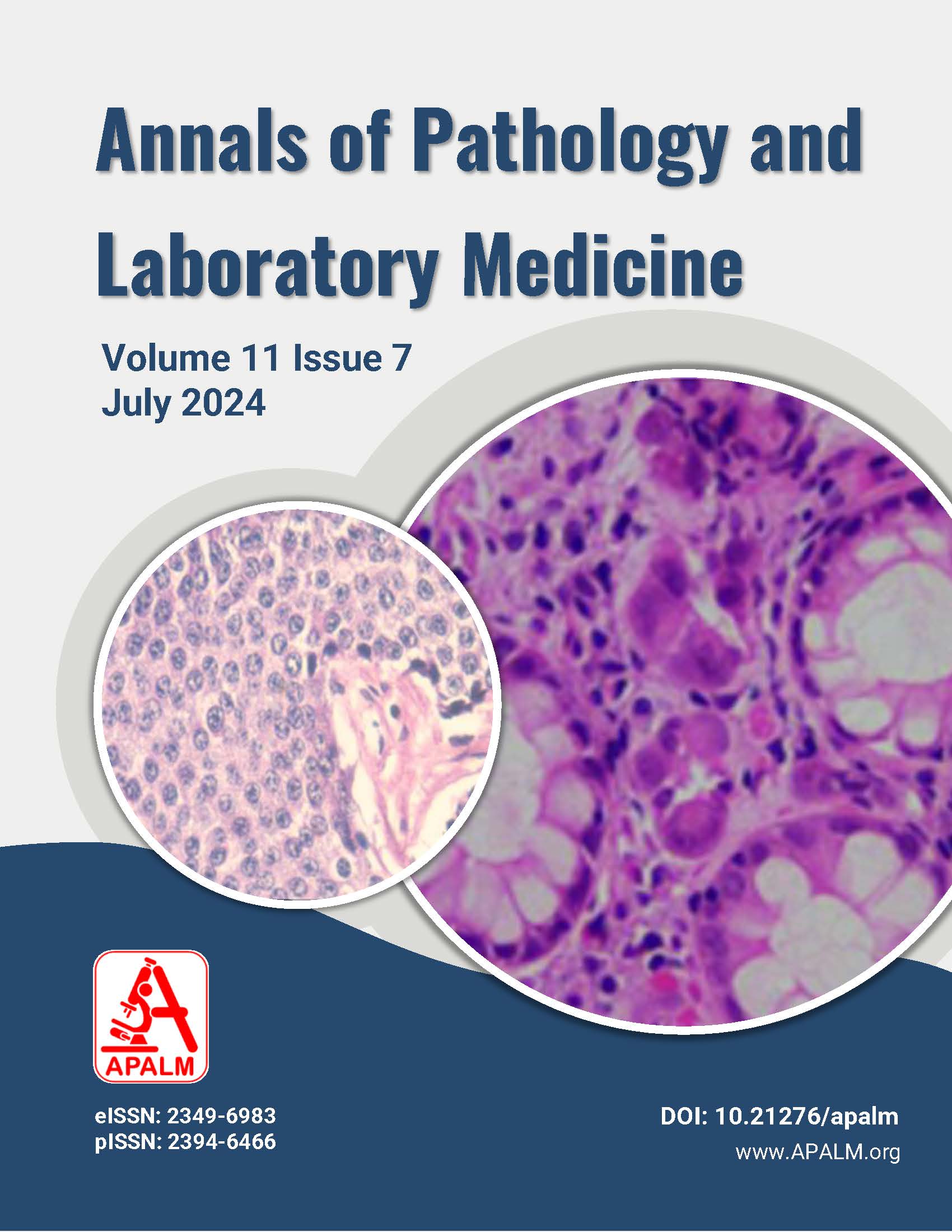Extraskeletal Myxoid Chondrosarcoma of Thigh: A Case of Uncertain Origin
DOI:
https://doi.org/10.21276/apalm.3332Keywords:
Extraskeletal Myxoid Chondrosarcoma, Thigh, Malignant, ChondromyxoidAbstract
Background: Extraskeletal myxoid chondrosarcoma (EMC) is a rare soft-tissue malignancy that accounts for less than 3% of all soft-tissue sarcomas. It arises in patients older than 35 years, with peak incidence during the 5th and 6th decades. It is distinguished from other sarcomas by its unique histology and a characteristic chromosomal translocation, typically t(9;22)(q22;q12.2), fusing EWSR1 to NR4A3.
Case details: A 60-year-old male presented with a slow-growing mass over the right side of his thigh for approximately one year. The patient complained of pain associated with the mass. FNAC showed a moderately cellular smear displaying chondromyxoid stroma. Suspicion of extraskeletal myxoid chondrosarcoma was made, and the mass was excised and sent to our department for histopathological examination. Grossly, the tumor was 16x14x10 cm, soft to firm, gray-tan colored, lobulated, and nodular. On the cut section, it had a gelatinous surface with cystic and solid areas. Microscopically, the tumor showed a multinodular pattern, with cells arranged in short cords and strands separated by myxoid material. Individual cells had round to oval nuclei with deeply eosinophilic cytoplasm. Few cells showed cytoplasmic vacuolization. Immunohistochemistry was done for further analysis using S100, Vimentin, and Synaptophysin.
Conclusion: Extraskeletal myxoid chondrosarcoma is a tumor of uncertain differentiation. It has intermediate-grade malignant potential and can show metastasis or recurrence. Surgical excision is the treatment modality of choice.
References
Shah PC, Hathilal RN, Sheth S, et al. Extraskeletal chondrosarcoma of thigh: a rare case report. Int J Res Med Sci. 2021 Jun;9(6):1778-81.
Cong Y, Fang X, Qiao G, et al. Primary extraskeletal myxoid chondrosarcoma with adenofibroma of the breast: a case report and literature review. Int J Clin Exp Med. 2018;11(4):4317-23.
Zhang L, Rongxu RW, Qin G, et al. Extraskeletal myxoid chondrosarcoma: a comparative study of imaging and pathology. Biomed Res Int. 2018;2018:1-9.
WHO Classification of Tumours Editorial Board. Soft tissue and bone tumours. 5th ed. Lyon: International Agency for Research on Cancer; 2020. p. 303-5.
Davis EJ, Wu YM, Robinson D, et al. Next generation sequencing of extraskeletal myxoid chondrosarcoma. Oncotarget. 2017;8(13):21770-7.
Ceylan K, Kizilkaya Z, Yavanoglu A. Extraskeletal myxoid chondrosarcoma of the nasal cavity. Eur Arch Otorhinolaryngol. 2006;263(11):1044-7.
Fidele NB, Tianfu W, Liu B, et al. Extraskeletal myxoid chondrosarcoma of the parotid gland. Ann Maxillofac Surg. 2019;9(2):439-43.
Zhou Q, Lu G, Liu A, et al. Extraskeletal myxoid chondrosarcoma in the lung: asymptomatic lung mass with severe anemia. Diagn Pathol. 2012;7:112.
Goldblum JR, Folpe AL, Weiss SW. Other malignant soft tissue tumors, including those of uncertain type. In: Enzinger & Weiss’s Soft Tissue Tumors. 7th ed. Canada: Elsevier; 2020. p. 1194-9.
Angiero F. Extraskeletal myxoid chondrosarcoma of left buccal mucosa. Anticancer Res. 2012;32(8):3345-50.
Drilon AD, Popat S, Bhuchar G, et al. Extraskeletal myxoid chondrosarcoma: a retrospective review from 2 referral centers emphasizing long-term outcomes with surgery and chemotherapy. Cancer. 2008;113(12):3364-71.
Downloads
Published
Issue
Section
License
Copyright (c) 2024 Kavita Tiwari, Kekhrieneniu Mere

This work is licensed under a Creative Commons Attribution 4.0 International License.
Authors who publish with this journal agree to the following terms:
- Authors retain copyright and grant the journal right of first publication with the work simultaneously licensed under a Creative Commons Attribution License that allows others to share the work with an acknowledgement of the work's authorship and initial publication in this journal.
- Authors are able to enter into separate, additional contractual arrangements for the non-exclusive distribution of the journal's published version of the work (e.g., post it to an institutional repository or publish it in a book), with an acknowledgement of its initial publication in this journal.
- Authors are permitted and encouraged to post their work online (e.g., in institutional repositories or on their website) prior to and during the submission process, as it can lead to productive exchanges, as well as earlier and greater citation of published work (See The Effect of Open Access at http://opcit.eprints.org/oacitation-biblio.html).










